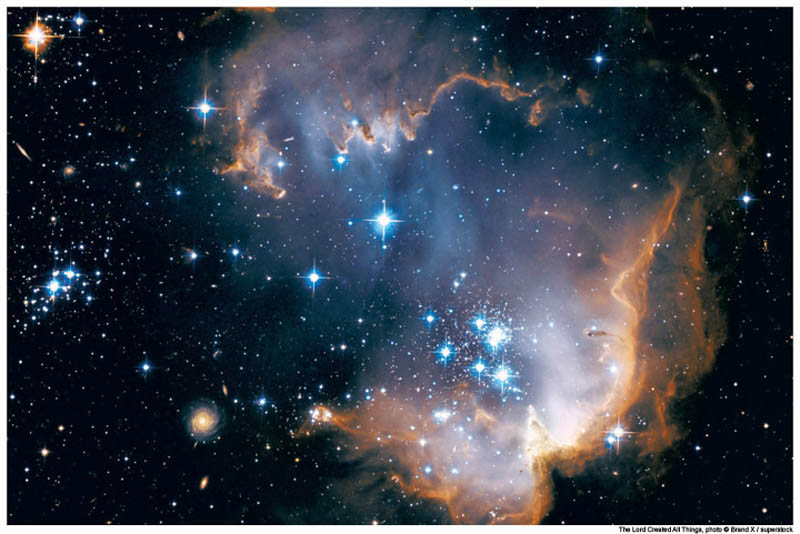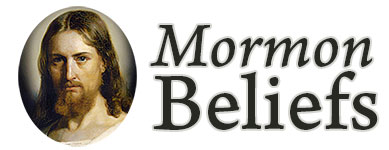The Creation
 Mormonism teaches more truths regarding the creation than any other faith. Much information is available in the Pearl of Great Price.
Mormonism teaches more truths regarding the creation than any other faith. Much information is available in the Pearl of Great Price.
Under the direction of Heavenly Father, Jesus Christ created the heavens and the earth (see Mosiah 3:8; Moses 2:1). From scripture revealed through the Prophet Joseph Smith, we know that in the work of the Creation, the Lord organized elements that had already existed (see Abraham 3:24). He did not create the world “out of nothing,” as some people believe.
“Now the word create came from the word baurau, which does not mean to create out of nothing; it means to organize; the same as a man would organize materials and build a ship. Hence we infer that God had materials to organize the world out of chaos—chaotic matter, which is element, and in which dwells all the glory. Element had an existence from the time He had. The pure principles of element are principles which can never be destroyed; they may be organized and reorganized, but not destroyed. They had no beginning, and can have no end” (Teachings of Joseph Smith, pp. 350-352).
Scriptures declare that heaven, earth, and all things upon the earth are divinely created. Scriptures also help us to know more about the partnership of God and His Son, Jesus Christ, in the Creation.
“Behold, I am Jesus Christ the Son of God. I created the heavens and the earth, and all things that in them are. I was with the Father from the beginning” (3 Nephi 9:15).
The first words in the Bible state, “In the beginning God created the heaven and the earth,” and, “God created man in his own image, … male and female created he them.” Scripture records the feelings of Heavenly Father for His Beloved Son and for each human being: “For God so loved the world, that he gave his only begotten Son, that whosoever believeth in him should not perish, but have everlasting life.” The creation is an integral part of the Plan of Salvation.
The Creation and the Plan of Salvation
God himself, the Father of us all, established a plan of salvation whereby his spirit children might progress and become like him. It is the gospel of God, the plan of Eternal Elohim, the system that saves and exalts, and it consists of three things. These three are the very pillars of eternity itself. They are the Creation, the Fall, and the Atonement.
Before we can even begin to understand the temporal creation of all things, we must know how these three eternal truths—the Creation, the Fall, and the Atonement—are inseparably woven together. No one of them stands alone; each of them ties into the other two; and without a knowledge of all of them, it is not possible to know the truth about any one of them.
The Fall was made possible because an infinite Creator made the earth and man and all forms of life in such a state that they could fall. This fall involved a change of status. All things were so created that they could fall or change, and thus was introduced the kind of existence needed to put into operation all of the terms of the Father’s eternal plan of salvation.
The first temporal creation of all things was paradisiacal in nature. In the Edenic day all forms of life lived in a higher and different state than now prevails. The coming fall would take them downward and forward and onward. Death and procreation had yet to enter the world. Death would be Adam’s gift to man, and the gift of God would be eternal life through Jesus Christ our Lord.
Knowing that the Creation is the father of the Fall, and that the Fall made possible the Atonement, and that salvation itself comes because of the Atonement, we are in a position to put the revealed knowledge about the Creation in a proper perspective.
“When the Lord shall come, he shall reveal all things,” our latter-day revelations tell us—“Things which have passed, and hidden things which no man knew, things of the earth, by which it was made, and the purpose and the end thereof” (Doctrine and Covenants 101:32–33). Pending the Millennium, it is our responsibility to believe and accept that portion of the truth about the Creation that has been dispensed to us.
Christ is the Creator and Redeemer of worlds so numerous that they cannot be numbered by man. As to his infinite and eternal creative and redemptive enterprises the divine word attests: “And worlds without number have I created,” saith the Father, “and I also created them for mine own purpose; and by the Son I created them, which is mine Only Begotten. … But only an account of this earth, and the inhabitants thereof, give I unto you.” As to all of the other worlds of the Lord’s creating we know only that it is his work and his glory “to bring to pass”—through the Redeemer—“the immortality and eternal life” of all their inhabitants (Moses 1:33, 35, 39).
The Plan of Salvation teaches us about the “pre-existence,” when we dwelled with God as His spirit-children. This spiritual existence actually included all of God’s earthly creations:
The Lord says that he created “every plant of the field before it was in the earth, and every herb of the field before it grew. … And I, the Lord God, had created all the children of men; and not yet a man to till the ground; for in heaven created I them” (Moses 3:5). Clearly he is speaking of the premortal existence of all things. This earth, all men, animals, fish, fowls, plants, all things—all lived first as spirit entities. Their home was heaven, and the earth was created to be the place where they could take upon themselves mortality.
“For I, the Lord God, created all things, of which I have spoken, spiritually, before they were naturally upon the face of the earth.” Apply these words to the spirit creation, if you will, and they will be true in such a context. But they have a much more pointed and important meaning. They are followed by the statement: “For I, the Lord God, had not caused it to rain upon the face of the earth; … and there was not yet flesh upon the earth, neither in the water, neither in the air; But I, the Lord God, spake, and there went up a mist [on the earth], and watered the whole face of the ground” (Moses 3:5–6). The Lord is here telling us about the events of which he has spoken, about the events of the “six days,” about the account of the physical or tangible or temporal creation set forth in chapter 2 of Moses. He says the things so made were “spiritually” created and were not “naturally upon the face of the earth.”
Continuing the divine commentary about the Creation, we read: “And I, the Lord God, formed man from the dust of the ground, and breathed into his nostrils the breath of life; and man became a living soul, the first flesh upon the earth, the first man also; nevertheless, all things were before created; but spiritually were they created and made according to my word” (Moses 3:7). How filled with meaning are these words! The physical body of Adam is made from the dust of the very earth to which the Gods came down to form him. His “spirit” enters his body, as Abraham expresses it. (See Abraham 5:7.) Man becomes a living, immortal soul; body and spirit are joined together. He has been created “spiritually,” as all things were because there is as yet no mortality. Then Adam falls; mortality and procreation and death commence. Fallen man is mortal; he has mortal flesh; he is “the first flesh upon the earth.” And the effects of his fall pass upon all created things. They fall in that they too become mortal. Death enters the world; mortality reigns; procreation commences; and the Lord’s great and eternal purposes roll onward.
Thus, “all things” were created as spirit entities in heaven; then “all things” were created in a paradisiacal state upon the earth; that is, “spiritually were they created,” for there was as yet no death. They had spiritual bodies made of the elements of the earth as distinguished from the mortal bodies they would receive after the Fall when death would enter the scheme of things. Natural bodies are subject to the natural death; spiritual bodies, being paradisiacal in nature, are not subject to death. Hence the need for a fall and the mortality and death that grows out of it.
Thus, as the scripture explains, “I, the Lord God, planted a garden eastward in Eden, and there I put the man whom I had formed” (Moses 3:8). Adam, our father, dwelt in the Garden of Eden. He was the first man of all men in the day of his creation, and he became the first flesh of all flesh through the Fall. Because of the Fall, “all things changed from their spiritual state to a natural state. And thus we read: “And out of the ground made I, the Lord God, to grow every tree, naturally, that is pleasant to the sight of man; and man could behold it. And it became also a living soul. For it was spiritual in the day that I created it” (Moses 3:9; italics added). [1]
A summary of what we know about the Creation
- The Lord has created worlds without number, but they are numbered unto Him. As one earth passes away, another is being created (Moses 1:37).
- The earth was created out of unorganized matter and not created ex nihilo, or out of nothing.
- All of God’s creations were created through Jesus Christ.
- The Lord reveals knowledge about the creation to His prophets, but only knowledge relating to this earth (Moses 1:33).
- All living things upon the earth were created spiritually in a premortal existence before they were created physically upon the earth. (All living things will also be resurrected, because of the atonement of Christ.)
- The creation, the fall, and the atonement are all major elements of the Plan of Salvation.
- Adam and Eve were created in the image of God. In the Garden of Eden, they were immortal. After the fall, they became mortal.
- The six “days” of creation were actually six consecutive creative periods of unknown length.
